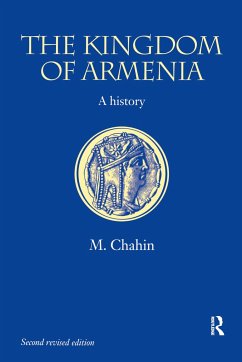- Broschiertes Buch
- Merkliste
- Auf die Merkliste
- Bewerten Bewerten
- Teilen
- Produkt teilen
- Produkterinnerung
- Produkterinnerung
This book covers the history of Armenia from the most ancient literate peoples of Mesopotamia, who had commercial interests in the land of Armenia (c. 2500 BC), to the end of the Middle Ages.
Andere Kunden interessierten sich auch für
![State and Tribe in Nineteenth-Century Afghanistan State and Tribe in Nineteenth-Century Afghanistan]() Christine NoelleState and Tribe in Nineteenth-Century Afghanistan64,99 €
Christine NoelleState and Tribe in Nineteenth-Century Afghanistan64,99 €![Qaidu and the Rise of the Independent Mongol State In Central Asia Qaidu and the Rise of the Independent Mongol State In Central Asia]() Michal BiranQaidu and the Rise of the Independent Mongol State In Central Asia66,99 €
Michal BiranQaidu and the Rise of the Independent Mongol State In Central Asia66,99 €![Reassessing Orientalism Reassessing Orientalism]() Reassessing Orientalism65,99 €
Reassessing Orientalism65,99 €![The Abkhazians The Abkhazians]() George HewittThe Abkhazians68,99 €
George HewittThe Abkhazians68,99 €![Pilgrimage in Tibet Pilgrimage in Tibet]() Alex McKayPilgrimage in Tibet44,99 €
Alex McKayPilgrimage in Tibet44,99 €![The Russian Orthodox Church, 1917-1948 The Russian Orthodox Church, 1917-1948]() Daniela KalkandjievaThe Russian Orthodox Church, 1917-194869,99 €
Daniela KalkandjievaThe Russian Orthodox Church, 1917-194869,99 €![Ancient Christianity in the Caucasus Ancient Christianity in the Caucasus]() Tamila MgaloblishviliAncient Christianity in the Caucasus66,99 €
Tamila MgaloblishviliAncient Christianity in the Caucasus66,99 €-
-
-
This book covers the history of Armenia from the most ancient literate peoples of Mesopotamia, who had commercial interests in the land of Armenia (c. 2500 BC), to the end of the Middle Ages.
Hinweis: Dieser Artikel kann nur an eine deutsche Lieferadresse ausgeliefert werden.
Hinweis: Dieser Artikel kann nur an eine deutsche Lieferadresse ausgeliefert werden.
Produktdetails
- Produktdetails
- Verlag: Taylor & Francis
- 2nd Revised edition
- Seitenzahl: 350
- Erscheinungstermin: 21. Dezember 2001
- Englisch
- Abmessung: 229mm x 155mm x 18mm
- Gewicht: 576g
- ISBN-13: 9780700714520
- ISBN-10: 0700714529
- Artikelnr.: 22017272
- Herstellerkennzeichnung
- Libri GmbH
- Europaallee 1
- 36244 Bad Hersfeld
- gpsr@libri.de
- Verlag: Taylor & Francis
- 2nd Revised edition
- Seitenzahl: 350
- Erscheinungstermin: 21. Dezember 2001
- Englisch
- Abmessung: 229mm x 155mm x 18mm
- Gewicht: 576g
- ISBN-13: 9780700714520
- ISBN-10: 0700714529
- Artikelnr.: 22017272
- Herstellerkennzeichnung
- Libri GmbH
- Europaallee 1
- 36244 Bad Hersfeld
- gpsr@libri.de
M. Chahin lectured on the Ancient History of the Near East at the University of Bristol.
Chronology of the Ancient Near East Maps Preface Introduction Prologue:
Some milestones in the ancient history of the Near East Part I. The Kingdom
or Urartu 1. The Land of Armenia 2. The 'Lost' Kingdom of Urartu 3. The
rise of the Kingdom of Urartu 4. Aramu (858-844 BC): The first known king
of Urartu 5. Sarduri I (844-828 BC): The first Vannic inscriptions 6.
Ishpuini the Establisher (828-810 BC) & Menua the Conqueror (810-785 BC) 7.
Argishti I (785-753 BC) and the Zenith of Urartian military power 8.
Sarduri II (753-735 BC): The Golden Age of Vannic Power 9. Rusa I (735-714
BC): Urarto-Assyrian balance of power upset 10. Argishti II (714-681 BC):
Urarto military recovery 11. Rusa II (680-639 BC): Urartu & Assyria at
peace 12. The last kings of Urartu 13. Political organisation: Towns &
buildings 14. Trade & commerce 15. Religion of Urartu 16. Art of Urartu 17.
Military equipment & costume 18. Ararat & Assyria: A brief review Part II.
The Kingdom of Armenia 19. Introduction 20. Early history 21. The Royal
House of Ervand (the Orontids) 22. The Royal House of Artashes (the
Artaxiads) 23. The Royal House of Arshak (the Arsacids) 24. The Royal House
of Bagrat (the Bagratids) 25. The Kingdom of Armenia in Cilicia 26.
Religion 27. Language & learning 28. Armenia's wealth of ecclesiastical
architecture Epilogue Plates Notes Bibliography Index
Some milestones in the ancient history of the Near East Part I. The Kingdom
or Urartu 1. The Land of Armenia 2. The 'Lost' Kingdom of Urartu 3. The
rise of the Kingdom of Urartu 4. Aramu (858-844 BC): The first known king
of Urartu 5. Sarduri I (844-828 BC): The first Vannic inscriptions 6.
Ishpuini the Establisher (828-810 BC) & Menua the Conqueror (810-785 BC) 7.
Argishti I (785-753 BC) and the Zenith of Urartian military power 8.
Sarduri II (753-735 BC): The Golden Age of Vannic Power 9. Rusa I (735-714
BC): Urarto-Assyrian balance of power upset 10. Argishti II (714-681 BC):
Urarto military recovery 11. Rusa II (680-639 BC): Urartu & Assyria at
peace 12. The last kings of Urartu 13. Political organisation: Towns &
buildings 14. Trade & commerce 15. Religion of Urartu 16. Art of Urartu 17.
Military equipment & costume 18. Ararat & Assyria: A brief review Part II.
The Kingdom of Armenia 19. Introduction 20. Early history 21. The Royal
House of Ervand (the Orontids) 22. The Royal House of Artashes (the
Artaxiads) 23. The Royal House of Arshak (the Arsacids) 24. The Royal House
of Bagrat (the Bagratids) 25. The Kingdom of Armenia in Cilicia 26.
Religion 27. Language & learning 28. Armenia's wealth of ecclesiastical
architecture Epilogue Plates Notes Bibliography Index
Chronology of the Ancient Near East Maps Preface Introduction Prologue:
Some milestones in the ancient history of the Near East Part I. The Kingdom
or Urartu 1. The Land of Armenia 2. The 'Lost' Kingdom of Urartu 3. The
rise of the Kingdom of Urartu 4. Aramu (858-844 BC): The first known king
of Urartu 5. Sarduri I (844-828 BC): The first Vannic inscriptions 6.
Ishpuini the Establisher (828-810 BC) & Menua the Conqueror (810-785 BC) 7.
Argishti I (785-753 BC) and the Zenith of Urartian military power 8.
Sarduri II (753-735 BC): The Golden Age of Vannic Power 9. Rusa I (735-714
BC): Urarto-Assyrian balance of power upset 10. Argishti II (714-681 BC):
Urarto military recovery 11. Rusa II (680-639 BC): Urartu & Assyria at
peace 12. The last kings of Urartu 13. Political organisation: Towns &
buildings 14. Trade & commerce 15. Religion of Urartu 16. Art of Urartu 17.
Military equipment & costume 18. Ararat & Assyria: A brief review Part II.
The Kingdom of Armenia 19. Introduction 20. Early history 21. The Royal
House of Ervand (the Orontids) 22. The Royal House of Artashes (the
Artaxiads) 23. The Royal House of Arshak (the Arsacids) 24. The Royal House
of Bagrat (the Bagratids) 25. The Kingdom of Armenia in Cilicia 26.
Religion 27. Language & learning 28. Armenia's wealth of ecclesiastical
architecture Epilogue Plates Notes Bibliography Index
Some milestones in the ancient history of the Near East Part I. The Kingdom
or Urartu 1. The Land of Armenia 2. The 'Lost' Kingdom of Urartu 3. The
rise of the Kingdom of Urartu 4. Aramu (858-844 BC): The first known king
of Urartu 5. Sarduri I (844-828 BC): The first Vannic inscriptions 6.
Ishpuini the Establisher (828-810 BC) & Menua the Conqueror (810-785 BC) 7.
Argishti I (785-753 BC) and the Zenith of Urartian military power 8.
Sarduri II (753-735 BC): The Golden Age of Vannic Power 9. Rusa I (735-714
BC): Urarto-Assyrian balance of power upset 10. Argishti II (714-681 BC):
Urarto military recovery 11. Rusa II (680-639 BC): Urartu & Assyria at
peace 12. The last kings of Urartu 13. Political organisation: Towns &
buildings 14. Trade & commerce 15. Religion of Urartu 16. Art of Urartu 17.
Military equipment & costume 18. Ararat & Assyria: A brief review Part II.
The Kingdom of Armenia 19. Introduction 20. Early history 21. The Royal
House of Ervand (the Orontids) 22. The Royal House of Artashes (the
Artaxiads) 23. The Royal House of Arshak (the Arsacids) 24. The Royal House
of Bagrat (the Bagratids) 25. The Kingdom of Armenia in Cilicia 26.
Religion 27. Language & learning 28. Armenia's wealth of ecclesiastical
architecture Epilogue Plates Notes Bibliography Index








